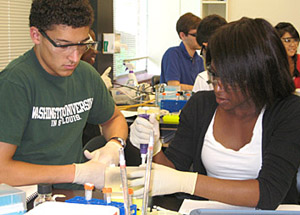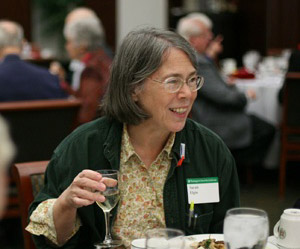On May 20, the Howard Hughes Medical Institute (HHMI) announced new grants totaling $79 million that will help universities strengthen undergraduate and precollege science education nationwide. The resources will let faculty at research universities pursue some of their most creative ideas by developing new ways to teach and inspire students about science and research.

HHMI is making the awards through its Precollege and Undergraduate Science Education Program and the HHMI Professors Program — two complementary initiatives that are transforming science education in the United States.
Washington University in St. Louis was one of 50 institutions chosen from a field of 165 research-focused universities to receive a 2010 Research University Grant. The university will receive $1.6 million over a period of four years to develop creative, research-based courses and curricula; to give more students vital experience working in the lab; and to improve science teaching from elementary school through college.
The grants include support for a small group of leading research scientists who are committed to making science more engaging to undergraduates. One of 13 awardees, Sarah C. R. Elgin, PhD, the Viktor Hamburger Professor and professor of biology and education in Arts & Sciences and professor of biochemistry and molecular biophysics and genetics in the School of Medicine, will receive $800,000 over four years to focus on solving important problems facing science education, such as how best to bring research into the classroom, stimulate interdisciplinary thinking, and encourage students from diverse backgrounds to become scientists.
“HHMI is committed to funding education programs that excite students’ interest in science,” says HHMI President Robert Tjian. “We hope that these programs will shape the way students look at the world — whether those students ultimately pursue a career in science or not.”
“By funding both initiatives, we are assured that both research universities and individual professors will make important contributions to science education,” says Peter J. Bruns, HHMI’s vice president for grants and special programs. “We want to inspire scientists to think as hard about improving science education as they do about their research.”
At WUSTL real science keeps students interested

Many undergrads learn about genomics from textbooks and lectures. At Washington University in St. Louis, freshmen in a special genomics course have learned by doing. Working in small teams, they isolated and sequenced the DNA of phages — bacteria-infecting viruses that look like something out of War of the Worlds, only in nanoscale. “It not only taught them about genomics and genomic analysis but also resulted in a real contribution to our knowledge base,” says Kathryn Miller, PhD, professor of biology and chair of the biology department.
The course, part of HHMI’s Science Education Alliance, is just one piece of a widespread effort to change how science is taught at Washington University. That experience will shape how the university utilizes part of its new HHMI grant, which is aimed at helping faculty members make changes throughout the curriculum so that teaching and learning about science better reflect the scientific process. “These curriculum projects allow faculty to collaborate across departments and cross-fertilize ideas of how to teach, what to teach, and how to support the students,” Miller says. “They encourage faculty across the university to think creatively about their teaching and about how to engage students successfully.”
One important goal is to bring authentic research experiences to more students. To do that, the university will incorporate a streamlined version of the phage research project into the standard introductory biology lab course. The phage course will also become an integral part of an introductory computer science lab. “Students in introductory computer science classes will be using biological examples for some of their programming projects,” Miller says. “That’s one of the projects that we’re most excited about.”
The faculty members are also excited about making changes to large classes — organic chemistry, immunology, and introductory biology — so the classes focus more on students’ understanding of how scientists ask and answer questions, with students working in groups to solve scientific problems. And students like the changes too. After the recent introduction of real-world experiments to an undergraduate physical chemistry lab, Miller says, “It went from a course taken by a fraction of the chem majors to something that’s very popular and bulging at the seams with students who seem very enthusiastic about what they’re doing.”
Sarah Elgin’s contagious enthusiasm

WUSTL photo
Sarah Elgin, shown here at an Eliot Society gathering, has been an HHMI professor since 2002.
Elgin remembers being drawn to science as a child because it offered a concrete way to understand the world around her. “I liked poking and prodding things,” she says. “I wanted to figure how they worked.” It’s that joy in learning new things that has pushed Elgin to create a program that provides the same opportunity for her students at Washington University.
Elgin does research on genomes, a field of study focused on the DNA sequence of individuals and organisms. In the past 15 years, high-throughput machines that can quickly determine an organism’s DNA sequence have revolutionized the field, turning it from a lab-based field that looked at the genome one gene at a time to a computationally-based field focused on large-scale data collection and analysis, a field now referred to as “genomics.”
As the field has become increasingly complex and data-oriented in recent years, Elgin realized that her students no longer had the same sort of easy access to the science that she had loved as a kid. Biologists often spent their days studying numbers on computer screens, not microscope slides wriggling with life.
Elgin thought she could motivate students by having them play a real role in the scientific process — not just sitting in a classroom jotting down notes — so she decided to develop a curriculum to do just that. “The goal is twofold. One is to bring more genomics into the undergraduate curriculum, most of which was written before we knew how to sequence genomes. The other goal is to do it in such a way that students are actually involved in the research project,” she explains.
The result was a research-based course where students learn to work with large data sets and work with the School of Medicine’s Genome Sequencing Center in transforming a genome’s raw sequence data into a more polished, finished sequence. The task of sifting through mountains of data to find relevant information requires both brute force and brainpower. “Think of a genome like a copy of Moby Dick — but instead of being its usual thick volume, it’s 20 times longer because someone has inserted gibberish at random places,” Elgin says. “Our job is to find the sentences.” Computers have gotten good at finding the ‘words’ within a genome, but they often fail to construct good sentences. The students analyze the computer output and learn to use several lines of evidence to construct testable models of genes and chromosomes.
As she was developing and testing the curriculum, Elgin quickly realized that there was so much interesting work to do that the class could become a nationwide effort that provided a research experience for students across the nation. With the help of her colleagues at Washington University, that vision became the Genomics Education Partnership, which Elgin began in 2005 with her first HHMI professor grant. The partnership now includes more than 60 colleges and universities across the country that provide students the opportunity to work on large-scale DNA sequencing projects.
The work is challenging in its own right, but it also offers students an opportunity to move the science forward. The results of the students’ work serves as a foundation for papers that Elgin and others submit for publication in research journals; two journal articles based on the scientific research have been published since 2006. The information also goes into a national database that scientists use for their own research. In addition, the GEP faculty have published two papers in the science education literature to help others adopt this style of teaching.
For students, the chance to do something that matters is an incentive to do top-notch work. Currently, the project focuses on the fruit fly’s dot chromosome, which may hold important information about genome organization and gene expression. “Students are so excited to do something that doesn’t end up in the wastebasket at the end of the semester,” says Elgin, who also serves as an advisor for HHMI’s Science Education Alliance. “They’ve been apprentices for so long, and they’re just dying for the chance to do something real.”
This press release is adapted from HHMI releases.